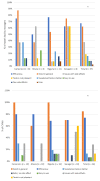Perception of Malaria Chemoprevention Interventions in Infants and Children in Eight Sub-Saharan African Countries: An End User Perspective Study
- PMID: 34064620
- PMCID: PMC8163176
- DOI: 10.3390/tropicalmed6020075
Perception of Malaria Chemoprevention Interventions in Infants and Children in Eight Sub-Saharan African Countries: An End User Perspective Study
Abstract
Preventive chemotherapy interventions have been identified as key tools for malaria prevention and control. Although a large number of publications have reported on the efficacy and safety profile of these interventions, little literature exists on end-user experience. The objective of this study was to provide insights on the perceptions and attitudes towards seasonal malaria chemoprevention (SMC) and intermittent preventive treatment of infants (IPTi) to identify drivers of and barriers to acceptance. A total of 179 in-depth qualitative interviews were conducted with community health workers (CHWs), health center managers, parents of children receiving chemoprevention, and national decision makers across eight countries in sub-Saharan Africa. The transcribed verbatim responses were coded and analyzed using a thematic approach. Findings indicate that, although SMC is largely accepted by end users, coverage remained below 100%. The main causes mentioned were children's absenteeism, children being sick, parents' reluctance, and lack of staff. Regarding IPTi, results from participants based in Sierra Leone showed that the intervention was generally accepted and perceived as efficacious. The main challenges were access to water, crushing the tablets, and high staff turnover. SMC and IPTi are perceived as valuable interventions. Our study identified the key elements that need to be considered to facilitate the expansion of these two interventions to different geographies or age groups.
Keywords: children and infants; end user; implementation; intermittent preventive treatment of infants (IPTi); malaria chemoprevention; seasonal malaria chemoprevention (SMC).
Conflict of interest statement
The authors declare no conflict of interest.
Figures





Similar articles
-
Coverage of intermittent preventive treatment of malaria in infants after four years of implementation in Sierra Leone.Malar J. 2023 May 2;22(1):145. doi: 10.1186/s12936-023-04575-6. Malar J. 2023. PMID: 37127633 Free PMC article.
-
Community response to intermittent preventive treatment of malaria in infants (IPTi) delivered through the expanded programme of immunization in five African settings.Malar J. 2009 Aug 10;8:191. doi: 10.1186/1475-2875-8-191. Malar J. 2009. PMID: 19664250 Free PMC article.
-
Community response to intermittent preventive treatment of malaria in infants (IPTi) in Papua New Guinea.Malar J. 2010 Dec 22;9:369. doi: 10.1186/1475-2875-9-369. Malar J. 2010. PMID: 21176197 Free PMC article. Clinical Trial.
-
Contextual Factors to Improve Implementation of Malaria Chemoprevention in Children: A Systematic Review.Am J Trop Med Hyg. 2023 Dec 11;110(1):69-78. doi: 10.4269/ajtmh.23-0478. Print 2024 Jan 3. Am J Trop Med Hyg. 2023. PMID: 38081055 Free PMC article.
-
Coverage of intermittent preventive treatment and insecticide-treated nets for the control of malaria during pregnancy in sub-Saharan Africa: a synthesis and meta-analysis of national survey data, 2009-11.Lancet Infect Dis. 2013 Dec;13(12):1029-42. doi: 10.1016/S1473-3099(13)70199-3. Epub 2013 Sep 18. Lancet Infect Dis. 2013. PMID: 24054085 Review.
Cited by
-
Perennial malaria chemoprevention with and without malaria vaccination to reduce malaria burden in young children: a modelling analysis.Malar J. 2023 Apr 24;22(1):133. doi: 10.1186/s12936-023-04564-9. Malar J. 2023. PMID: 37095480 Free PMC article.
-
Chemoprevention for the Populations of Malaria Endemic Africa.Diseases. 2022 Nov 8;10(4):101. doi: 10.3390/diseases10040101. Diseases. 2022. PMID: 36412595 Free PMC article.
-
Perceived barriers and opportunities for the introduction of post-discharge malaria chemoprevention (PDMC) in five sub-Saharan countries: a qualitative survey amongst malaria key stakeholders.Malar J. 2024 Sep 6;23(1):270. doi: 10.1186/s12936-024-05100-z. Malar J. 2024. PMID: 39243086 Free PMC article.
-
Seasonal malaria chemoprevention in Africa and China's upgraded role as a contributor: a scoping review.Infect Dis Poverty. 2023 Jul 5;12(1):63. doi: 10.1186/s40249-023-01115-x. Infect Dis Poverty. 2023. PMID: 37403183 Free PMC article.
-
Field testing of user-friendly perennial malaria chemoprevention packaging in Benin, Côte d'Ivoire and Mozambique.Malar J. 2024 May 21;23(1):157. doi: 10.1186/s12936-024-04977-0. Malar J. 2024. PMID: 38773567 Free PMC article.
References
-
- WHO World Malaria Report 2020. [(accessed on 6 April 2021)]; Available online: https://www.who.int/malaria/publications/world-malaria-report-2020/en/
-
- WHO Guidelines for Malaria. 16 February 2021. [(accessed on 6 April 2021)]; Available online: https://www.who.int/publications/i/item/WHO-UCN-GMP-2021.01.
-
- WHO . Guidelines for the Treatment of Malaria. 3rd ed. World Health Organization; Geneva, Switzerland: 2015. [(accessed on 25 June 2020)]. Available online: https://www.who.int/malaria/publications/atoz/9789241549127/en/
-
- WHO Policy Recommendation: Seasonal Malaria Chemoprevention (SMC) for Plasmodium Falciparum Malaria Control in Highly Seasonal Transmission Areas of the Sahel Sub-Region in Africa. [(accessed on 25 June 2020)];2012 Available online: https://www.who.int/malaria/publications/atoz/who_smc_policy_recommendat...
LinkOut - more resources
Full Text Sources

